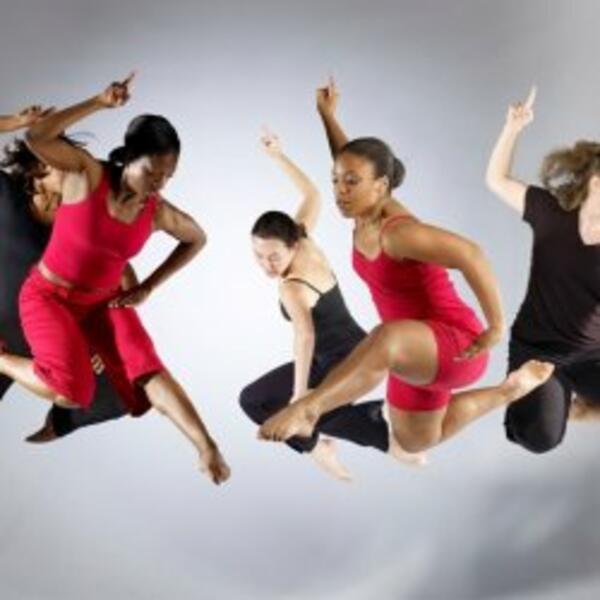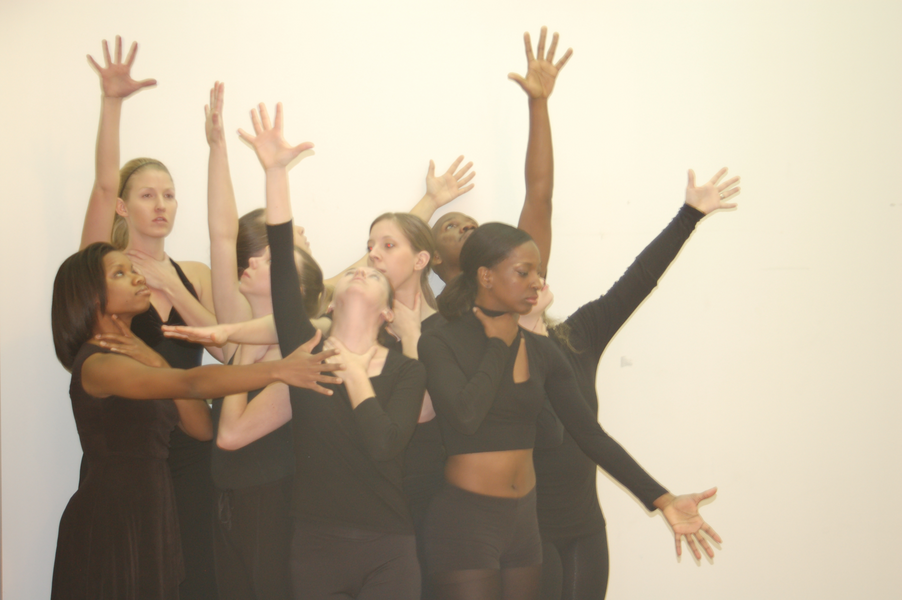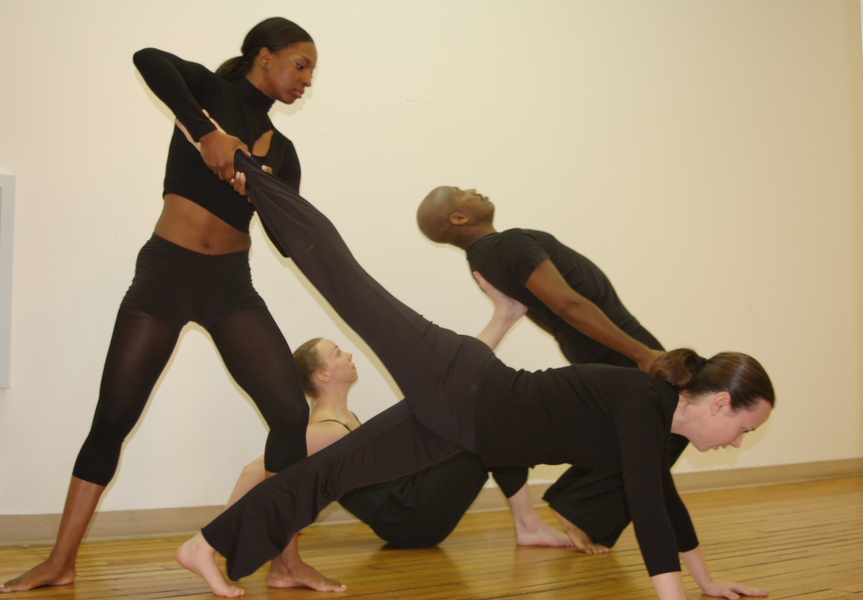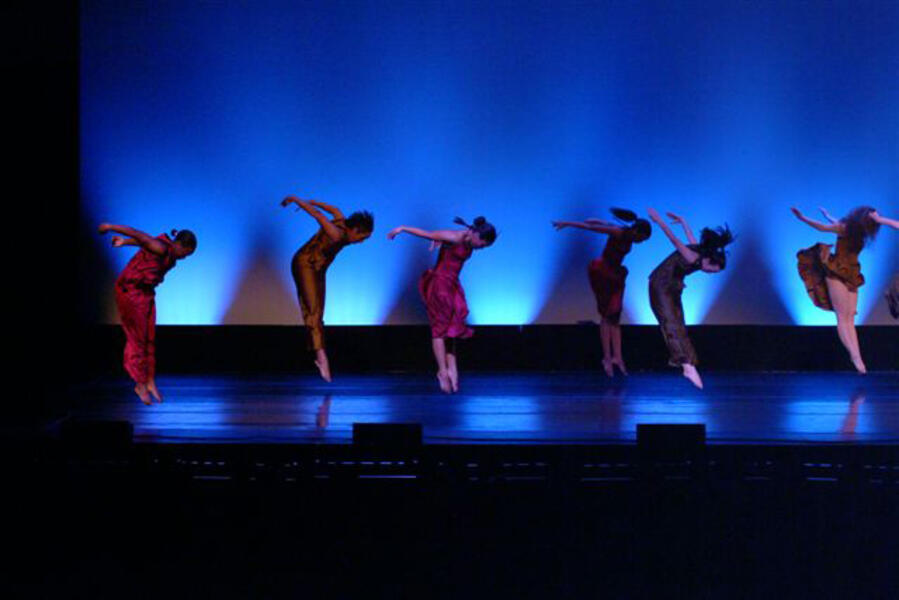Borders Uncrossed
Article written by Christina Royster-Hemby
Baltimore City Paper
Two lithe women--one black, one white--saunter toward each other from opposite ends of a well-lit room. As they meet in the center, their arms extend forward and they clutch each other by the throat. They hold this pose for a moment before reluctantly letting go and turning away, heading to opposite ends of the room. A few beats later, two different women--one black, one white--sail past each other, this time saying the words suggested by the dancers' movements: "I hate white people" and "I hate black people," each uttered with whispered, half-spit venom.
These exchanges were part of Full Circle Dance Company's latest program, Borders Uncrossed, which debuted at the Baltimore Museum of Art for Black History Month in 2007.
Racial differences are more about the ugly, deep-rooted ideas that are left unsaid, society writ large symbolized by the black and white dancers here. And even though Full Circle choreographed several dances for Borders Uncrossed to explore racial differences and suggest a path to racial dialogue, the dancers felt that at the end of the day the usual hatred will win out.
"This is a project we had fear about," said Donna Jacobs. "We're an interracial dance company," she says. "Do we have to bring in a facilitator to handle this [subject]? Would thoughts and latent opinions and experiences come out in our dance that would injure people?"
The project began when dancers were discussing topics for their next show. Madi Jackson, a Full Circle dancer and choreographer, suggested doing something on race. So the company, as it usually does, sponsored a community forum on race to inform their eventual dances.
Only about 20 people showed up, many of whom were Full Circle members. "Not everybody wants to talk about race," Jacobs says. "Many times people don't know how their opinions will be perceived by someone else. They don't know what is safe to say and how others will judge you based on what you said."
The members of Full Circle decided that, for this particular subject, conferring among the company was a more effective strategy. They talked about race in an intimate, familiar setting about racial slurs, misconceptions and stereotypes, interracial relationships, special treatment or the lack thereof. And what they found is that the more things change, the more they stay the same.
One of the younger company members shared with Jacobs how when she walks down her street one family stands outside and yells "nigger" as she walks by. An older member shared a story of his house being shot at by the Ku Klux Klan when he was a growing up 30 years ago. Some white members talked about growing up in all-white communities where they really didn't have to deal with race. These memories and stories showed up in their dances.
Jacobs said, "there have been moments when I have [asked myself], `Have I gone too far? Did I say too much? Was that last button the one I shouldn't have pushed?'" Jacobs added that when the dancers had to say hurtful things to one another she watched their body motions to see if such sentiments came through in their other movements.
"Deep Bayou," choreographed by Jacobs, was set to Nina Simone's "Four Women," and in it the dancers--some biracial, some black--danced in motions expressed their racial backgrounds. Their struggles were all different, but their dances were equally intense. In the dance's second section, a black dancer portrayed a character who is tired, weary, and near death from a long life of servitude.
"This project made us a more cohesive unit," said Liz Pelton. "We felt that we got a lot closer, even though we delved into these hard issues...individuals can learn a lot from each other and make progress."
Another dancer shared how skin color is an arduous road even within a family unit. April Lawyer, one of eight children, and her younger brother are the darkest-skinned of them all, and he uses foundation to lighten his skin. Lawyer added, "I wanted him to be aware that he's not alone. All of us are going through it."
And that's what Jackson and Jacobs meant when they said they fear that race is never going to go away. "They may shift and manifest in various ways, but I don't know if [racial issues] will ever go away," Jackson said, "which is the whole reason for the piece."
------------------------------------------------------------------------------
Religion provides solace and inspiration, motivates charity, and unites diverse communities. It also fuels bloody battles across the globe, provokes debate over the rights of women and gays, and wields hidden power over the political process. Religionâ??s complex history of comfort and conflict stretches across the millennia, as old as human culture itself.
In February 2008, local and visiting choreographers brought together their own visions of the human spiritual impulse. Sacred Body: In Response to Religion, was an evening of inspired and inspirational new works resulting from a yearlong project exploring religion, faith, and culture. Weaving the personal stories and spiritual questions of members of the community into an interdisciplinary sensory experience, Sacred Body engaged the souls, minds, eyes, ears, and even hands of the participating audience.
Drawing on the powerful postures of prayer found in different religions from around the world, Ohio-based choreographer Travis Gatling created a work both personal and universal. Filled with both appreciation and questioning of his own religious upbringing, it is a visually stunning symbolic representation of one personâ??s spiritual journey.
Baltimore choreographer Erica Feriozziâ??s intimate, serenely beautiful choreography drew on Buddhist and Christian source material, inviting the audience to experience the stillness and peace central to several faiths.
Baltimore physician/choreographer Misty Borstâ??s work offered an alternative paradigm founded in science. Her odd and quirky movements made vivid the marvels of the communities of life, often invisible, that surround us.
Full Circle Dance Company director Donna Jacobsâ??s narrative, historical work explored the central place of the Bible and Christianity in the African American journey from slavery to citizenship. It is a story of suffering and endurance, of faith and strength that will both move and educate. Her work, titled "Unforsaken," earned Ms. Jacobs the Mark Ryder Original Choreography Award in 2009 from the Howard County Arts Council. Ms. Jacobs's second work for the Sacred Body project, "Worthy," was an uplifting expression of praise performed to stunning live gospel music by Alton Scarborough.
Sacred Body also featured a special collaborative work that incorporated ideas about religion and spirituality contributed through community discussions.
-------------------------------------------------------------------------------
What are you most afraid of? Failure? Death? Being alone? How do these fears shape your life? What does the self you display to the world conceal? What dreams, aspirations, or dark thoughts lurk beneath the surface? What might your nightmares reveal about the life you lead? Can understanding your dreams shed light on who you are?
Tackling these questions head-on, Baltimoreâ??s Full Circle Dance Company embarked on an ambitious project entitled The Unconscious: Dreams and Fears. With a grant from the city of Baltimore and with involvement from the community, the company created six new works by six choreographers from Baltimore and beyondâ??all exploring aspects of the mind. Intended as an intensive choreographic crucible to showcase diverse perspectives and approaches, the project culminated in a performance at the Baltimore Museum of Art.
As with previous thematic projects exploring race, religion, and motherhood, Full Circle invited members of the community to participate in its artistic journey. Working with schoolchildren on related choreography and soliciting ideas from Baltimoreans of all ages, the dancers and choreographers uncovered rich source material for their work.
â??We always like to look beyond our own circle for different perspectives,â? explained company director Donna Jacobs. â??What surprised us this time is the universality of some of our fearsâ??fear of failure for example. That theme is sure to arise in some of the new choreography that is underway.â?
Washington-based choreographer Hope Byers explored ways some of these universal fears hold us back, imposing limits and restricting our freedom. Her athletic, intense work reflected an internal struggle: we sometimes cling to our fears even as we wish we could escape them.
The very strangeness of the human psyche can make us laugh, as choreographer Misty Borst demonstrated. Her new work peeked into the minds of apparently calm office workers to reveal extraordinary fantasiesâ??some light and others dark.
Dante Jeniferâ??s new dance made vivid a surreal nightmare that reflected the tumultuous experience of childhood in todayâ??s world.
Donna Jacobs explored shadows, both literal and figurative.
And Theresa DeAngelo pushes angst aside in a dreamy celebration of love.
The Unconscious also included a new work by Ohio-based choreographer Travis Gatling, whose sumptuous movement style and gift for conveying emotional truth have made him a favorite choreographer among Baltimore dance audiences.
Two Full Circle favorites that are relevant to the theme completed the evening. Donna Jacobs's "Spirits Fallen" a revival of the first work ever created for Full Circle Dance Company, demonstrated a haunting yet joyful dream of dance after death. And Erica Feriozzi's "Balance" revealed how mind and body are joined in a meditative search for tranquility.
Article written by Christina Royster-Hemby
Baltimore City Paper
Two lithe women--one black, one white--saunter toward each other from opposite ends of a well-lit room. As they meet in the center, their arms extend forward and they clutch each other by the throat. They hold this pose for a moment before reluctantly letting go and turning away, heading to opposite ends of the room. A few beats later, two different women--one black, one white--sail past each other, this time saying the words suggested by the dancers' movements: "I hate white people" and "I hate black people," each uttered with whispered, half-spit venom.
These exchanges were part of Full Circle Dance Company's latest program, Borders Uncrossed, which debuted at the Baltimore Museum of Art for Black History Month in 2007.
Racial differences are more about the ugly, deep-rooted ideas that are left unsaid, society writ large symbolized by the black and white dancers here. And even though Full Circle choreographed several dances for Borders Uncrossed to explore racial differences and suggest a path to racial dialogue, the dancers felt that at the end of the day the usual hatred will win out.
"This is a project we had fear about," said Donna Jacobs. "We're an interracial dance company," she says. "Do we have to bring in a facilitator to handle this [subject]? Would thoughts and latent opinions and experiences come out in our dance that would injure people?"
The project began when dancers were discussing topics for their next show. Madi Jackson, a Full Circle dancer and choreographer, suggested doing something on race. So the company, as it usually does, sponsored a community forum on race to inform their eventual dances.
Only about 20 people showed up, many of whom were Full Circle members. "Not everybody wants to talk about race," Jacobs says. "Many times people don't know how their opinions will be perceived by someone else. They don't know what is safe to say and how others will judge you based on what you said."
The members of Full Circle decided that, for this particular subject, conferring among the company was a more effective strategy. They talked about race in an intimate, familiar setting about racial slurs, misconceptions and stereotypes, interracial relationships, special treatment or the lack thereof. And what they found is that the more things change, the more they stay the same.
One of the younger company members shared with Jacobs how when she walks down her street one family stands outside and yells "nigger" as she walks by. An older member shared a story of his house being shot at by the Ku Klux Klan when he was a growing up 30 years ago. Some white members talked about growing up in all-white communities where they really didn't have to deal with race. These memories and stories showed up in their dances.
Jacobs said, "there have been moments when I have [asked myself], `Have I gone too far? Did I say too much? Was that last button the one I shouldn't have pushed?'" Jacobs added that when the dancers had to say hurtful things to one another she watched their body motions to see if such sentiments came through in their other movements.
"Deep Bayou," choreographed by Jacobs, was set to Nina Simone's "Four Women," and in it the dancers--some biracial, some black--danced in motions expressed their racial backgrounds. Their struggles were all different, but their dances were equally intense. In the dance's second section, a black dancer portrayed a character who is tired, weary, and near death from a long life of servitude.
"This project made us a more cohesive unit," said Liz Pelton. "We felt that we got a lot closer, even though we delved into these hard issues...individuals can learn a lot from each other and make progress."
Another dancer shared how skin color is an arduous road even within a family unit. April Lawyer, one of eight children, and her younger brother are the darkest-skinned of them all, and he uses foundation to lighten his skin. Lawyer added, "I wanted him to be aware that he's not alone. All of us are going through it."
And that's what Jackson and Jacobs meant when they said they fear that race is never going to go away. "They may shift and manifest in various ways, but I don't know if [racial issues] will ever go away," Jackson said, "which is the whole reason for the piece."
------------------------------------------------------------------------------
Religion provides solace and inspiration, motivates charity, and unites diverse communities. It also fuels bloody battles across the globe, provokes debate over the rights of women and gays, and wields hidden power over the political process. Religionâ??s complex history of comfort and conflict stretches across the millennia, as old as human culture itself.
In February 2008, local and visiting choreographers brought together their own visions of the human spiritual impulse. Sacred Body: In Response to Religion, was an evening of inspired and inspirational new works resulting from a yearlong project exploring religion, faith, and culture. Weaving the personal stories and spiritual questions of members of the community into an interdisciplinary sensory experience, Sacred Body engaged the souls, minds, eyes, ears, and even hands of the participating audience.
Drawing on the powerful postures of prayer found in different religions from around the world, Ohio-based choreographer Travis Gatling created a work both personal and universal. Filled with both appreciation and questioning of his own religious upbringing, it is a visually stunning symbolic representation of one personâ??s spiritual journey.
Baltimore choreographer Erica Feriozziâ??s intimate, serenely beautiful choreography drew on Buddhist and Christian source material, inviting the audience to experience the stillness and peace central to several faiths.
Baltimore physician/choreographer Misty Borstâ??s work offered an alternative paradigm founded in science. Her odd and quirky movements made vivid the marvels of the communities of life, often invisible, that surround us.
Full Circle Dance Company director Donna Jacobsâ??s narrative, historical work explored the central place of the Bible and Christianity in the African American journey from slavery to citizenship. It is a story of suffering and endurance, of faith and strength that will both move and educate. Her work, titled "Unforsaken," earned Ms. Jacobs the Mark Ryder Original Choreography Award in 2009 from the Howard County Arts Council. Ms. Jacobs's second work for the Sacred Body project, "Worthy," was an uplifting expression of praise performed to stunning live gospel music by Alton Scarborough.
Sacred Body also featured a special collaborative work that incorporated ideas about religion and spirituality contributed through community discussions.
-------------------------------------------------------------------------------
What are you most afraid of? Failure? Death? Being alone? How do these fears shape your life? What does the self you display to the world conceal? What dreams, aspirations, or dark thoughts lurk beneath the surface? What might your nightmares reveal about the life you lead? Can understanding your dreams shed light on who you are?
Tackling these questions head-on, Baltimoreâ??s Full Circle Dance Company embarked on an ambitious project entitled The Unconscious: Dreams and Fears. With a grant from the city of Baltimore and with involvement from the community, the company created six new works by six choreographers from Baltimore and beyondâ??all exploring aspects of the mind. Intended as an intensive choreographic crucible to showcase diverse perspectives and approaches, the project culminated in a performance at the Baltimore Museum of Art.
As with previous thematic projects exploring race, religion, and motherhood, Full Circle invited members of the community to participate in its artistic journey. Working with schoolchildren on related choreography and soliciting ideas from Baltimoreans of all ages, the dancers and choreographers uncovered rich source material for their work.
â??We always like to look beyond our own circle for different perspectives,â? explained company director Donna Jacobs. â??What surprised us this time is the universality of some of our fearsâ??fear of failure for example. That theme is sure to arise in some of the new choreography that is underway.â?
Washington-based choreographer Hope Byers explored ways some of these universal fears hold us back, imposing limits and restricting our freedom. Her athletic, intense work reflected an internal struggle: we sometimes cling to our fears even as we wish we could escape them.
The very strangeness of the human psyche can make us laugh, as choreographer Misty Borst demonstrated. Her new work peeked into the minds of apparently calm office workers to reveal extraordinary fantasiesâ??some light and others dark.
Dante Jeniferâ??s new dance made vivid a surreal nightmare that reflected the tumultuous experience of childhood in todayâ??s world.
Donna Jacobs explored shadows, both literal and figurative.
And Theresa DeAngelo pushes angst aside in a dreamy celebration of love.
The Unconscious also included a new work by Ohio-based choreographer Travis Gatling, whose sumptuous movement style and gift for conveying emotional truth have made him a favorite choreographer among Baltimore dance audiences.
Two Full Circle favorites that are relevant to the theme completed the evening. Donna Jacobs's "Spirits Fallen" a revival of the first work ever created for Full Circle Dance Company, demonstrated a haunting yet joyful dream of dance after death. And Erica Feriozzi's "Balance" revealed how mind and body are joined in a meditative search for tranquility.
-
 thumb_sacredbody.jpg
thumb_sacredbody.jpg -
 thumb_unconscious.jpg
thumb_unconscious.jpg -
 Borders UncrossedPictured: Company Photo courtesy of Erica Feriozzi
Borders UncrossedPictured: Company Photo courtesy of Erica Feriozzi -
 Borders UncrossedPictured: Hope Byers and Liz Pelton Photo courtesy of Erica Feriozzi
Borders UncrossedPictured: Hope Byers and Liz Pelton Photo courtesy of Erica Feriozzi -
 Deep BayouPhoto of company performing "Deep Bayou" as part of the Borders Uncrossed project Photo courtesy of Tisa Della Volpe "Love, grief, and sensuality play equal parts in this profoundly personal drama."
Deep BayouPhoto of company performing "Deep Bayou" as part of the Borders Uncrossed project Photo courtesy of Tisa Della Volpe "Love, grief, and sensuality play equal parts in this profoundly personal drama." -
 Deep BayouPhoto of the company performing "Deep Bayou" as part of the Borders Uncrossed project Photo courtesy of Tisa Della Volpe "Love, grief, and sensuality play equal parts in this profoundly personal drama."
Deep BayouPhoto of the company performing "Deep Bayou" as part of the Borders Uncrossed project Photo courtesy of Tisa Della Volpe "Love, grief, and sensuality play equal parts in this profoundly personal drama."





